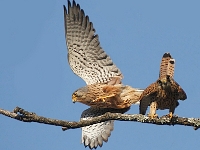| Kingdom: Animalia Phylum: Chordata Class: Aves (Birds) Order: Falconiformes Family: Falconidae |
 Common Kestrel (Falco tinnunculus) - photo © Rajiv Lather
close-up photo of Common Kestrel (female) by Yeshey Dorji Common Kestrel (Falco tinnunculus) is a widespread winter visitor and local resident in India. Kestrels are diurnal and prefer an "open country" habitat found in fields, heaths, and marshland. When hunting, the Kestrel hovers, almost stationary, about 10-20 m above the ground searching for prey. Once prey is sighted, the Kestrel makes a short, steep dive toward the target. Size: 33-35 cm. Wingspan: 72-80 cm Weight: 160-240 gm Call: shrill 'kee-kee-kee' Identification: Brick red above with grey head; light buff below with brown spearhead spots. In flight pointed black wings and rounded grey tail with broad black terminal band can be seen. Male has a dark moustachial stripe. Females and juveniles have rufous crown and nape streaked with black. Nest: Kestrels use old nests of other birds or nest in holes in trees, cliff ledges or even man-made structures, such as motorway bridges. 3-5 eggs are laid around late April to May, with about two days between each egg. Incubation, done only by the female, takes 26-30 days. Once hatched, the chicks grow at a very fast rate. Food is fetched by the male and brought directly to the nest; or left close by, the male then calls to the female to get her to collect the food. The young are fully fledged in 4-5 weeks after hatching, but stay with the parents to be fed for up to 4 more weeks, before they have all their hunting skills, including the ability to hover. Food: Common Kestrel's main diet consists of mice, lizards, small birds, locusts and other insects. |
 birding.in
birding.in
| Birds | Bird Diagram | Ornithology | Indian Sites | Bird Watching | Migration | North India | Birds of India | Haryana |
All rights reserved. Copyright © 2005-2013 Birds and birding in India. Disclaimer
website: Free Java Guide & Tutorials
